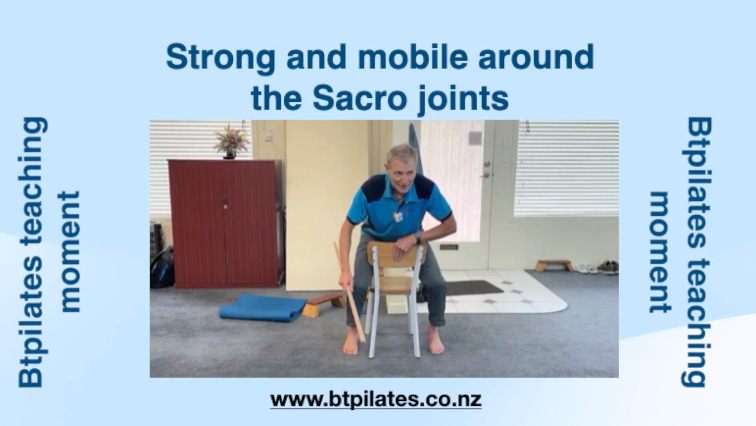Lesson in movement: hip hikes on the footstool and reverse chair jockey
You'll be in your 100's and you'll balance on one leg with your eyes shut!
(4 minute video)
The sacroiliac joints and the lowest two spinal joints contribute the most to lower back pain. You'll require strength exercises—medium to high load—with these joints near the midpoint of their range of motion. Additionally, you need to enhance your awareness of the movements that can cause damage to these joints. Mobilisation is also necessary—a low-load exercise—to re-integrate neural control. All of this is covered in this 3-minute clip, and you'll have some fun at the end too same time.
Transcript
I’ll head over to the footstool again for hip hikes. This is a mobilization for those four really delicate - well they're not delicate - they're really strong joints - but they get tremendous forces through them: the sacroiliac joints -
All right - I better stop talking and just tell you what I want you to do. You put a finger on the side hip - it may be two fingers. Send the side hip up, send the side hip down. Now the knees might bend a little, but not too much. Hip down, hip up - and the fingers will tell you. - Use the stick for balance if you need to, but just really - just have it there.
So there's two Sacro joints and there's 2 lower spinal joints - 4 joints that are easily damaged because of the huge forces that go through them but now we're just mobilizing them (gently and slowly), and getting them to rebuild their awareness so your balance will get better, because these four joints are getting some nice gentle mobilization. You're getting a lot of side muscle strength as well.
So - 2 fingers on the side. I'm not sure what everyone's doing. I hope you're doing what I'm doing. But you can see OK? it's four joints, two either side of your tailbone, 2 in the lower spine. They get sprained quite easily - just like an ankle can get sprained - and you need gentle mobilization to get the neural control back.
Now you'll have such good balance you'll be in your hundreds, and you'll be able to stand on one leg with your eyes shut! That's it! - The smoother you can do this, the more likely that you'll actually still have really good balance, and make sure that you're really sound in wind and limb. I’ll just get you set up with another exercise...
Wind and limb yeah! Just find a chair, see if you have a wall, a footstool, and a chair, maybe a broomstick, you can immediately just grab and say, “Oh, what does Bruce do with these things?” And you can work out your own things, and it’s just really nice. I think this is my favorite. ..
It's a reverse chair sit, you come up and make like a jockey. I'll get you in the picture here. You got goggles on. You're in a race. It’s a muddy track. The mud’s flying up into your face. You get down low and maybe, you know, you’re just going with the horse.. Your heels are just off the ground. All right. So, we want to make sure the knees are a little bit wide, maybe you’re riding a really fat horse. And you can curl your toes in and we'll do that for… we'll do it another 15 seconds, about 30 seconds left… And just keep that going. No problem. Get down or low – because you're racing!





